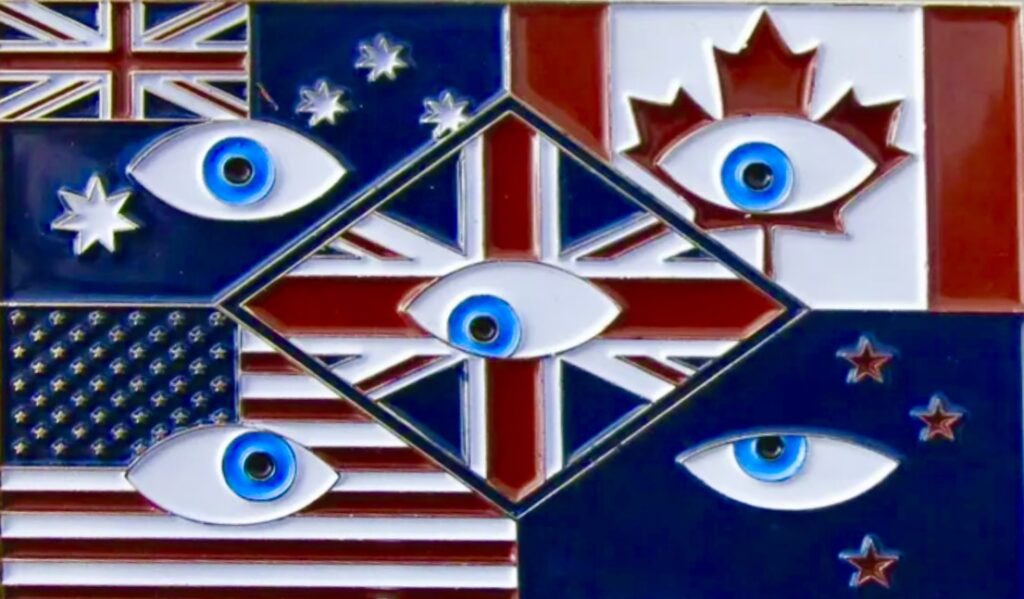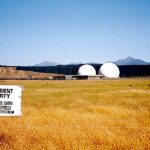- A review of The Secret History of the Five Eyes: The Untold Story of the International Spy Network by Richard Kerbaj; John Blake Publishing, 2022.
- With reference to Secret: The Making of Australia’s Security State, by Brian Toohey; Melbourne University Publishing, 2019.
During a time of considerable Islamophobia following the 9/11 attacks, Melbourne-based journalist Richard Kerbaj landed a job at Rupert Murdoch’s The Australian newspaper in 2006. He was assigned to an investigation of what was being said by senior Muslim clerics in their sermons in Australia. The aim was to identify if they were inciting a terrorist jihad in the community.
Sheikh Taj El-Din Hilaly, Australia’s most senior Muslim cleric, was recorded making a comment comparing immodestly dressed women to ‘uncovered meat’. Such a view would not have been considered particularly unusual in parts of the Muslim community, nor was it confined to it.
The exposé brought Kerbaj accolades and career progression at The Australian which posted him to London where Australian High Commissioner John Dauth was asked by News Corp veteran and arch conservative journalist at The Australian, Greg Sheridan, to take care of him. At a dinner Dauth hosted he sat Kerbaj next to the UK’s most senior spy, the head of MI5, the UK’s domestic spying agency.
The Secret History of the Five Eyes Eyes: The Untold Story of the International Spy Network reveals the extent of access Kerbaj is given to an impressive line-up of former spy chiefs, Prime Ministers and a host of unnamed senior intelligence operatives to document a history of this ‘band of brothers and sisters’, as he refers to the characters who have contributed to the Western ‘Five Eyes’ alliance.
The ‘Five Eyes’ alliance is the intelligence sharing network between Australia, New Zealand, the US, Canada and Britain, a development from the original UKUSA agreement between those countries.
The book provides the opportunity for Western intelligence chiefs to hail the growing importance of their own agencies without any pointy discussion of the purpose of the Five Eyes alliance today. The work however does reveal some gripping historical material, beginning in the World War Two era.
From its offices in New York’s Rockefeller Plaza, MI6 [British Security Coordination] organised ‘mass propaganda campaigns in the American mainstream media’ to overturn public opinion against the US entering World War Two.
‘[MI6] had an estimated 1,000 agents and sub-agents working for it, including broadcasters, political activists and operatives who specialised in document forgery, poll manipulation to misrepresent public opinion and the planting of false news into US media.’ (our emphasis)
Though the fading British empire had shown the way, it was soon supplanted by the rising global power and the US was to allocate far greater human and financial resources to the activity.
The Cold War spawned the CIA and an expanded role for the FBI under J Edgar Hoover, a ruthless ideologue. Escalated operations to halt the ‘communist scourge’ saw the inclusion of further partners.
ASIO, Australia’s national domestic security organisation, earnt its stripes in the alliance, with the Petrov Affair in 1954, the operation yielding for then Liberal Prime Minister Robert Menzies two high profile defections who exposed over 500 hundred spies around the world, and an election win.
The member countries’ agencies cooperated but also withheld crucial information from each other. Nonetheless, the fight against communism and later the ‘War on Terror’ after 9/11 sustained the alliance in spite of what were considered betrayals and temporary obstacles along the way.
The pages devoted to events leading to the sacking of Prime Minister Gough Whitlam in 1975, including the treachery of Defence Chief Arthur Tange, leave no doubt as to the grave consternation within the CIA caused by Whitlam’s determination to scrutinise ASIO and CIA-controlled facilities in Australia.
Although Governor General John Kerr clarified his authority to sack the Prime Minister, flagging it with the Queen and the Palace as he is required to do and receiving no advice or caution to the contrary, Kerbaj states: ‘Forty-five years later, in July 2020, it was revealed that Kerr had not sought the Queen’s approval for Whitlam’s dismissal.’ But as we know, from the declassified Palace Letters documents,the support was implicit.

US President Richard Nixon and his National Security Advisor Henry Kissinger had been shaken by several matters regarding the new Labor government – particularly Labor’s stinging public criticism of the US Christmas 1972 bombing campaign on North Vietnam’s capital, Hanoi, and by the Labor Attorney-General Lionel Murphy’s 1973 raid on ASIO headquarters, seeking files withheld about terrorism in Australia.
After Australian journalist Brian Toohey named Richard Stallings, the CIA officer who had been the head of the CIA/NSA satellite surveillance base at Pine Gap in Central Australia, on 3 November 1975, the CIA’s concern peaked.
ASIO received a message from the CIA on 9 November that ‘the continued reference to its organisation could “blow the lid off those installations in Australia… particularly the installation at Alice Springs” – Pine Gap. The message was reportedly shared that same day by an Australian defence department official with Sir John Kerr, Australia’s governor general’.
Whitlam was sacked two days later, on the day he was due to expose Stalling’s CIA connections in Parliament, but 19 days before the deadline for the purported reason for his sacking, the end of supply of government funds.
Much of the information (and more) surrounding events relating to Whitlam reproduced here was published in Brian Toohey’s Secret: The Making of Australia’s Security State. Importantly, in his 2019 book, Toohey also provides a detailed account of what the US military and spy facilities in Australia actually do.
This is a major missed opportunity for Kerbaj to examine the implications of the bases’ functions in the context of rising tensions between the US and China and the advent of AUKUS, the trilateral security pact announced in 2021 between Australia, the United Kingdom and the United States which will see the further integration of Australia’s defence capability with that of the US through enhanced submarine technology.
Toohey is a national security journalism veteran and his book reflects a commitment to examining the security apparatus along with its impact on our safety as well as democracy. However, Kerbaj’s book will appeal to a broader readership because he’s a better storyteller, making for a more entertaining read.
Much of Kerbaj’s work is engaging and populated with fascinating stories of spies and double agents. Among the accounts of treason is that of British nuclear scientist Klaus EJ Fuchs who assisted the US in building the first nuclear bomb and leaked his scientific paper to the Soviets, accelerating their creation of a nuclear bomb by at least two years. Fuchs was sentenced to 14 years in the UK.
Kerbaj covers the well known, CIA-led foreign interventions assisted (predominantly) by British intel agencies, and admits they have stoked anti-US hatred in the Middle East, South America and Asia. It’s a litany of fomenting unrest, financing and arming insurgents, shifting blame, toppling democratically-elected governments generally for economic reasons, and assassinations.
This includes the disastrous proxy war in Vietnam, and the CIA baiting of the Soviet Union in Afghanistan at the time of its invasion in 1979 – a plan hatched by Jimmy Carter’s National Security Advisor Zbigniew Brzezinski. The plan included a propaganda campaign to manipulate the media and lie about the provocations and timing of the CIA’s involvement, and the nature of the Mujahideen rebels.
It was a strategy that delivered success for the US, but not without significant future repercussions, including decades of terrorism blowback. After defeating the Soviets, the Taliban emerged as the dominant group among the Islamists who had been trained and armed by the CIA. Among them were Osama Bin Laden and his followers, who became known as al-Qaeda.
A substantial section of the book on the 2003 US-led invasion of Iraq and the details of the evidence of the non-existent WMDs (weapons of mass destruction) used to justify it – every piece of which was discredited – concludes with what Kerbaj defines as a turning point.
He argues the intelligence services, having themselves been manipulated by the White House and Downing Street, succumbed to the political imperative. The episode ‘contaminated operational thinking’.
However, whilst media coverage has since exposed much of this in graphic detail, as well as the flawed evidence on which the Iraq war was waged, Kerbaj has been too kind with respect to past behaviour of the Five Eye intelligence agencies.

This was no sudden onset of contamination of the agencies after 9/11. Intelligence agencies had long spied on their own citizens with the purpose of crushing dissent and discrediting individuals for their political ideology as Kerbaj himself has documented earlier in his book.
In covering various government enquiries in the UK and US after intelligence agency transgressions – some of which resulted in (limited) legislative change around the intelligence services – Kerbaj surprisingly, as he’s an Australian, does not mention the absence of such accountability mechanisms in Australia.
There’s a chapter devoted to Edward Snowden’s leaks and a fleeting mention of Wikileaks but merely as beneficiary of what Kerbaj accepts was a Russian hack in the run-up to the 2016 US Presidential election – though there is no conclusive proof the Democratic National Committee (DNC) server or computers were hacked.
Interestingly, he makes no mention at all of the content of the emails related to Hillary Clinton and her party’s internal corruption that subverted the presidential aspirations of socialist presidential candidate Bernie Sanders – an omission characteristic of the mainstream media at the time. Though Kerbaj says ‘Russia had planned to undermine the western political process’, the irony is that the information leaked showed in fact it was the DNC that had done precisely that.
Incredibly, Kerbaj does not avail himself of the trove of documents relating to intel services revealed by Wikileaks, that shed light on their role in current world flashpoints. And he makes no mention of a major breach of security at the CIA that resulted in the biggest leak in its history, published by WikiLeaks in 2017.
Known as the ‘Vault 7’ files, they exposed the CIA’s hacking arsenal, including its capacity to cover its tracks. To that end, half a dozen foreign language scripts are to be found, salted by the CIA in its hacking codes to obfuscate the source of the cyber-attacks, including Cyrillic (Russia), Farsi (Iran), and Mandarin (China).
It is inconceivable that this would not rate a mention in a full history of the Five Eyes, given its significance and the response of former CIA Director Mike Pompeo. Though the present charges against Wikileaks founder Julian Assange relate to the 2010 State Department releases, he was not indicted till Pompeo became Secretary of State during the Trump era.
Also not mentioned in the book is the reported CIA plot to murder Kerbaj’s fellow Australian journalist, Julian Assange.
Kerbaj also completely ignores a significant intelligence agency activity – economic spying. There is a long history of such spying by the CIA, including on allies for information on their fallback positions in tariff and trade negotiations, and initiatives on behalf of corporations as well, as documented by CIA whistleblower Philip Agee.
This activity today is mired in controversy and protected by extraordinary levels of secrecy and punishment of whistleblowers, as the Australian bugging of the East Timorese government offices during resource negotiations and the subsequent pursuit of the whistelblower Witness K and his lawyer Bernard Collaery reveal.
There is a concerning dissonance in the final sections of the book that deal with Russia and China where they are dismissed as evil, run by deluded, aggressive, authoritarian leaders, who among other faults never confess to hacking. The world becomes far more black and white, as if much of what was revealed in previous chapters didn’t happen, in line with the orthodox but dubious Western narrative on Chinese leader Xi Jinping and Russian President Vladimir Putin.
Kerbaj refers to the West as the ‘world’ when he writes Putin ‘has triggered worldwide support in both humanitarian and military aid’ after Moscow’s invasion of Ukraine in February this year, despite the majority of the world’s population being outside the NATO alliance countries.
Former British Prime Minister Theresa May tells Kerbaj that leaders have to be careful when questioning intelligence chiefs: ‘You can’t interfere in operational matters. It’s like dealing with the police […] there’s very clear operational independence.’ Kerbaj does not challenge this revealing admission of prime ministerial neglect, despite the very different accountability and transparency frameworks that apply to the police as opposed to the Secret Services.
In his final paragraph Kerbaj refers to the expanded responsibilities of the Five Eyes including ‘social-media arenas being used by rogue countries to push propaganda and hostile narratives against liberal democracies’.
One wonders how he can possibly conclude only ‘rogue states’ engage in propaganda, unless we are to assume he includes Britain and the US in that group of rogue nations, given the history of conduct he has documented earlier. Some of these Western social media information operations have been detailed by Declassified Australia in several past articles.
The Western alliance, he writes, ‘remains vital in attempting to foresee and combat future threats’, though we can’t help but be reminded of those it has created. The fawning is a missed opportunity to explain the real complexities of the intelligence alliance and to examine the ways in which it is creating our enemies, shaping public opinion and fuelling dangerous global tension.
It begs another comparison with Toohey’s conclusion in his masterful book, Secret: The Making of Australia’s Security State:
‘Avoiding catastrophe requires cooperation not mindless confrontation; dialogue not constant exploitation of unfounded fears. Fears spread by journalists in thrall to the national security state. This juggernaut has already shredded civil liberties in Australia. Now it is steering the country towards a cataclysmic, but unnecessary war [against China]. All in the name of making Australians safe!’
Readers will find some of the historical material in Kerbaj’s book of interest as well as his access to perspectives of the world’s Western intelligence services.
However it’s not possible to understand the purpose and function of an intelligence alliance of this magnitude today without a more nuanced appreciation of the present geopolitical context in which it operates, as well as shapes through its media operations.
For the alliance upholds a specific world order – one that functions according to rules set by the US – and one the intelligence alliance also contributes to creating.






